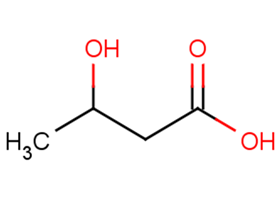
3-Hydroxybutyric acid
CAS No. 300-85-6
3-Hydroxybutyric acid( Butanoic acid )
Catalog No. M19752 CAS No. 300-85-6
3-Hydroxybutyric acid (or beta-hydroxybutyrate) is a ketone body. Like the other ketone bodies (acetoacetate and acetone) levels of 3-hydroxybutyrate in blood and urine are raised in ketosis. In humans 3-hydroxybutyrate is synthesized in the liver from acetyl-CoA and can be used as an energy source by the brain when blood glucose is low.
Purity : >98% (HPLC)
 COA
COA
 Datasheet
Datasheet
 HNMR
HNMR
 HPLC
HPLC
 MSDS
MSDS
 Handing Instructions
Handing Instructions
| Size | Price / USD | Stock | Quantity |
| 100MG | 37 | In Stock |


|
| 200MG | Get Quote | In Stock |


|
| 500MG | Get Quote | In Stock |


|
| 1G | Get Quote | In Stock |


|
Biological Information
-
Product Name3-Hydroxybutyric acid
-
NoteResearch use only, not for human use.
-
Brief Description3-Hydroxybutyric acid (or beta-hydroxybutyrate) is a ketone body. Like the other ketone bodies (acetoacetate and acetone) levels of 3-hydroxybutyrate in blood and urine are raised in ketosis. In humans 3-hydroxybutyrate is synthesized in the liver from acetyl-CoA and can be used as an energy source by the brain when blood glucose is low.
-
Description3-Hydroxybutyric acid (or beta-hydroxybutyrate) is a ketone body. Like the other ketone bodies (acetoacetate and acetone) levels of 3-hydroxybutyrate in blood and urine are raised in ketosis. In humans 3-hydroxybutyrate is synthesized in the liver from acetyl-CoA and can be used as an energy source by the brain when blood glucose is low. Blood levels of 3-hydroxybutyric acid levels may be monitored in diabetic patients to look for diabetic ketoacidosis. Persistent mild hyperketonemia is a common finding in newborns. Ketone bodies serve as an indispensable source of energy for extrahepatic tissues especially the brain and lung of developing mammals. Another important function of ketone bodies is to provide acetoacetyl-CoA and acetyl-CoA for the synthesis of cholesterol fatty acids and complex lipids. During the early postnatal period acetoacetate (AcAc) and beta-hydroxybutyrate are preferred over glucose as substrates for synthesis of phospholipids and sphingolipids in accord with requirements for brain growth and myelination. Thus during the first 2 weeks of postnatal development when the accumulation of cholesterol and phospholipids accelerates the proportion of ketone bodies incorporated into these lipids increases. On the other hand an increased proportion of ketone bodies is utilized for cerebroside synthesis during the period of active myelination. In the lung AcAc serves better than glucose as a precursor for the synthesis of lung phospholipids. The synthesized lipids particularly dipalmitoylphosphatidylcholine are incorporated into surfactant and thus have a potential role in supplying adequate surfactant lipids to maintain lung function during the early days of life . 3-Hydroxybutyric acid is found to be associated with fumarase deficiency and medium-chain acyl-CoA dehydrogenase deficiency which are inborn errors of metabolism.
-
In Vitro——
-
In Vivo——
-
SynonymsButanoic acid
-
PathwayProteasome/Ubiquitin
-
TargetEndogenous Metabolite
-
RecptorHuman Endogenous Metabolite
-
Research Area——
-
Indication——
Chemical Information
-
CAS Number300-85-6
-
Formula Weight104.1
-
Molecular FormulaC4H8O3
-
Purity>98% (HPLC)
-
SolubilityDMSO:10 mM
-
SMILESCC(O)CC(O)=O
-
Chemical Name——
Shipping & Storage Information
-
Storage(-20℃)
-
ShippingWith Ice Pack
-
Stability≥ 2 years
Reference
1.Hsu TT et al. 3-Hydroxybutyric acid interacts with lipid monolayers at concentrations that impair consciousness. Langmuir. 2013 Feb 12;29(6):1948-55.
molnova catalog



related products
-
Uvaol
Uvaol is present in olives and virgin olive oil with anti-inflammatory, anti-proliferative, and vasorelaxant activities.
-
3-Amino-2-piperidino...
3-Amino-2-piperidinone is a metabolite from all living organisms and can be used as a cyclic ornithine analogue.
-
trans-Aconitic acid
Trans-Aconitic acid is normally present in normal human urine and it has been suggested that is present in larger amounts with Reye's syndrome and organic aciduria. trans-Aconitic acid is a substrate of enzyme trans-aconitate 2-methyltransferase (EC 2.1.1.144).



 Cart
Cart
 sales@molnova.com
sales@molnova.com


